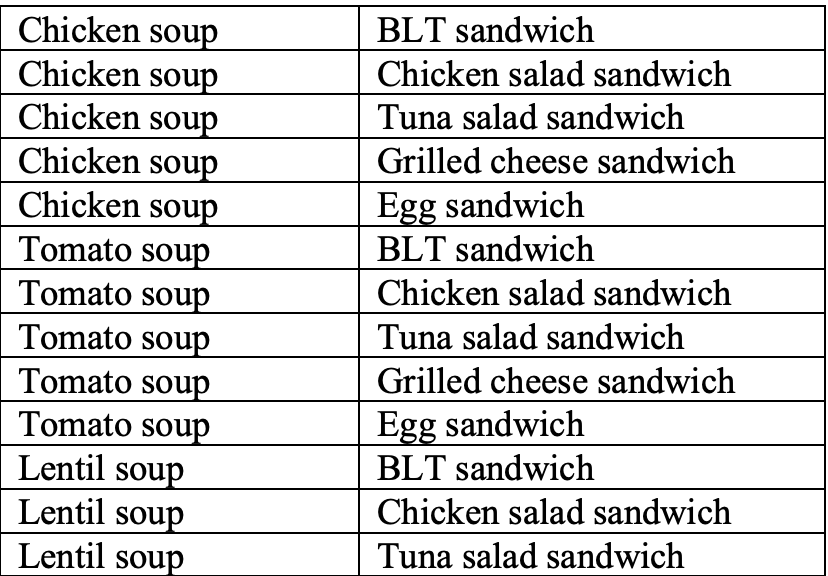General Information
Benchmark Instructional Guide
Connecting Benchmarks/Horizontal Alignment
Terms from the K-12 Glossary
Vertical Alignment
Previous Benchmarks
Next Benchmarks
Purpose and Instructional Strategies
In grade 8 and Algebra I Honors, students used organized lists, tables and tree diagrams to determine sample spaces for repeated experiments and determined sample spaces to help organize information when constructing relative frequency tables. In Math for College Liberal Arts, students consider new ways to organize data when solving real world problems involving the addition and multiplication rules for counting.- Instruction includes determining mutually exclusive events and using the addition rule for
counting with multiple events when there are no common outcomes. Given events A and
B are mutually exclusive events, where there are m outcomes of event A and n outcomes
of event B, then there are m + n outcomes of either events A or B.
- For example, when going to lunch at a local deli, Brendi has decided she would like either soup or a sandwich. The deli has 3 soup options and 5 sandwich options. Therefore, Brendi has 8 lunch options of soup or a sandwich.
- Instruction includes connecting the addition rule for counting with using combinations
(MA.912.DP.4.10).
- For example, from the box shown below with smiley-face erasers, determine how many ways we can choose 2 of the same color eraser.
- This can be calculated using combinations for the total number of ways to choose 2 yellow erasers from the 3 yellow erasers, 2 blue erasers from the 4 blue erasers and 2 green erasers from the 3 green erasers.
- The multiplication rule for counting, also known as the Fundamental Counting Principle,
is needed when at least two events must occur. Given independent events A and B, where
there are m outcomes of event A and n outcomes of event B, then there are m × n
outcomes events A and B can occur.
- For example, when going to lunch at a local deli, Brendi has decided she would like soup and a sandwich. The deli has 3 soup options and 5 sandwich options. Therefore, Brendi has 15 different lunch options of soup and a sandwich.
- Lists or tree diagrams may be useful in illustrating this principle.
- List


- Tree diagram
- Mathematical and real-world problems for this benchmark should include 2 or more events.
Common Misconceptions or Errors
- When using a tree diagram to count, students may create a separate tree for each possibility, rather than one tree branching out to each choice.
- Students may miss or double count choices if trying to use a list versus the rule.
- Students may confuse when addition versus multiplication is appropriate.
- Students may incorrectly believe the addition and multiplication rules for counting only apply to two events.
Instructional Tasks
Instructional Task 1 (MTR.5.1)- Giselle is having a 16th birthday party that includes a dessert bar. The bakery catering the
dessert bar has a variety of cakes, cupcakes, pies, cookies, and brownies.
- Part A. If the bakery has choices of 7 different cakes, 15 different cupcakes, 6 different pies, 12 different cookies and 3 different brownies, how many choices of desserts does Giselle have for her dessert bar?
- Part B. Giselle has decided she only wants cupcakes, cookies and brownies since they can easily be made as single servings. How many different desserts does she have to choose from now?
- Part C. Mandy is going to the party but doesn’t like cupcakes. How many dessert choices does she have? If Mandy decides she is going to have both a brownie and a cookie, how many possible combinations of desserts can she choose from to do so?
- Part D. Joey is also going and loves all desserts. If he decides to have a cupcake, a cookie and a brownie, how many combinations of desserts does Joey have to choose from? How many combinations of desserts does Joey have to choose from if he wants two of each?
- Part E. Using only pies and brownies from the bakery, find a way to have 23 combinations of different desserts.
Instructional Items
Instructional Item 1- Alexi is shopping at an electronics store for a new gaming system. Company P has 2 systems available, Company X has 3 systems available and Company N has one system available. Determine the total number of gaming systems from which Alexi can choose.
- Anderson is packing for vacation and included 5 shirts, 4 pairs of pants, 2 pairs of shoes and 3 hats. How many different outfits (shirt, pants, shoes and hat) will Anderson have on vacation?
